The human eye reveals more than just our vision capabilities. Through Iridología Diagnóstico de iris, practitioners analyze the colored part of your eye to identify potential health concerns before they manifest as symptoms. This ancient yet evolving practice offers a non-invasive alternative to conventional medical testing. But how does it truly compare to blood tests, imaging scans, and other traditional diagnostic methods? This comprehensive guide explores the science, applications, and effectiveness of iris analysis alongside conventional approaches to help you understand where each might fit in your health journey.
Qué es Iridología Diagnóstico de iris?
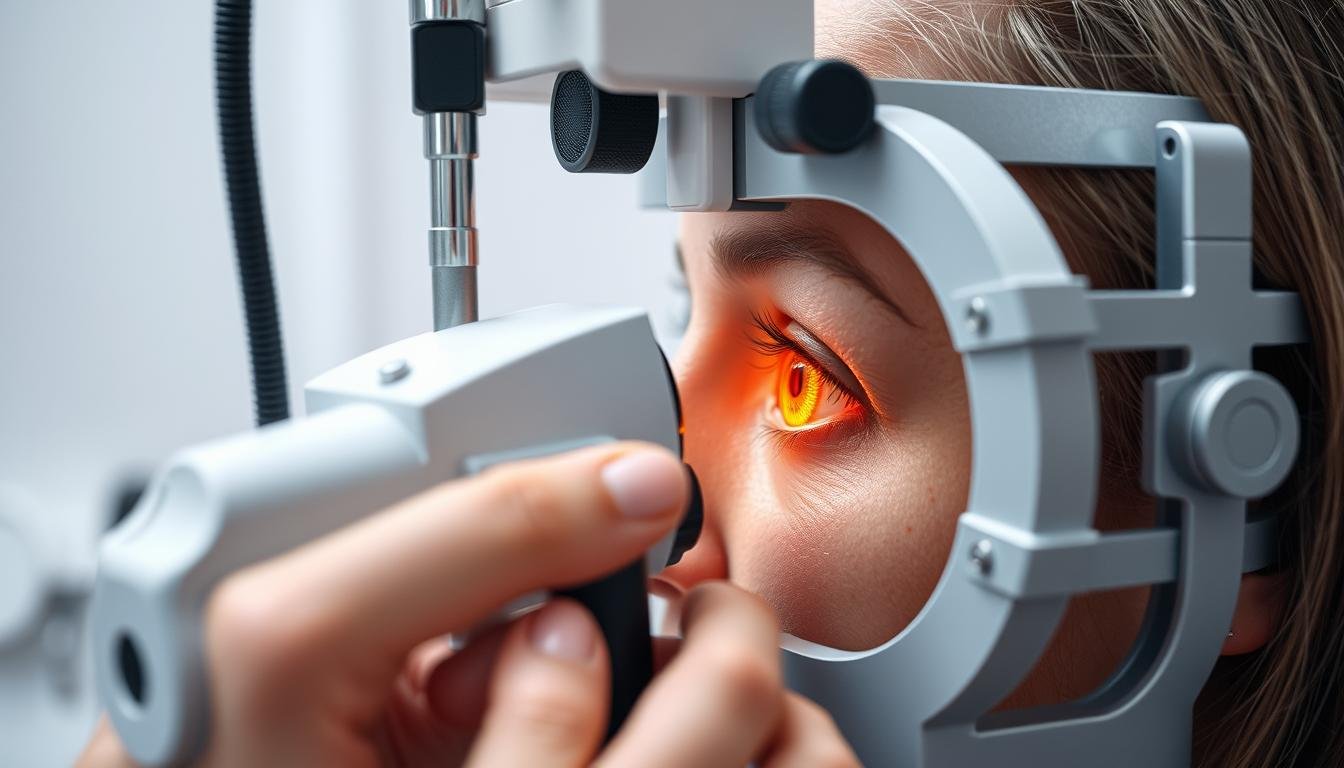
Professional iridologist examining a patient’s iris using specialized equipment
Iridología Diagnóstico de iris is the study of the iris (the colored part of the eye) to determine information about a person’s overall health status. This practice is based on the premise that each area of the iris corresponds to different organs and systems within the body. Practitioners believe that changes in iris patterns, colors, and markings can indicate imbalances, inflammation, or potential health issues in corresponding body parts.
Unlike conventional medical tests that often require blood samples, radiation exposure, or invasive procedures, iridology offers a completely non-invasive approach. The iridologist simply examines the iris visually or uses specialized cameras to capture detailed images for analysis. This gentle approach makes it appealing to those seeking alternative or complementary health assessments.
History of Iridología Diagnóstico de iris
The roots of iridology can be traced back thousands of years to ancient civilizations in Egypt, China, and India. However, modern iridology as we know it today began taking shape in the 19th century. Hungarian physician Dr. Ignatz von Peczely is often credited with developing the first detailed iris chart in the 1860s after noticing changes in an owl’s iris following an injury.
The story goes that as a child, von Peczely captured an owl that broke its leg during the struggle. He observed a dark mark appear in the owl’s iris at the time of injury. Later, as the leg healed, he noticed the mark changed in appearance. This observation sparked his interest in the connection between iris markings and physical conditions, leading him to develop the first comprehensive iris chart mapping body regions to specific areas of the iris.
In the early 20th century, Dr. Bernard Jensen further developed these concepts in the United States, creating more detailed iris charts and bringing iridology to wider attention. Today, modern technology has enhanced the practice with high-resolution digital imaging and sophisticated analysis software.
Mapping the Iris: Core Principles
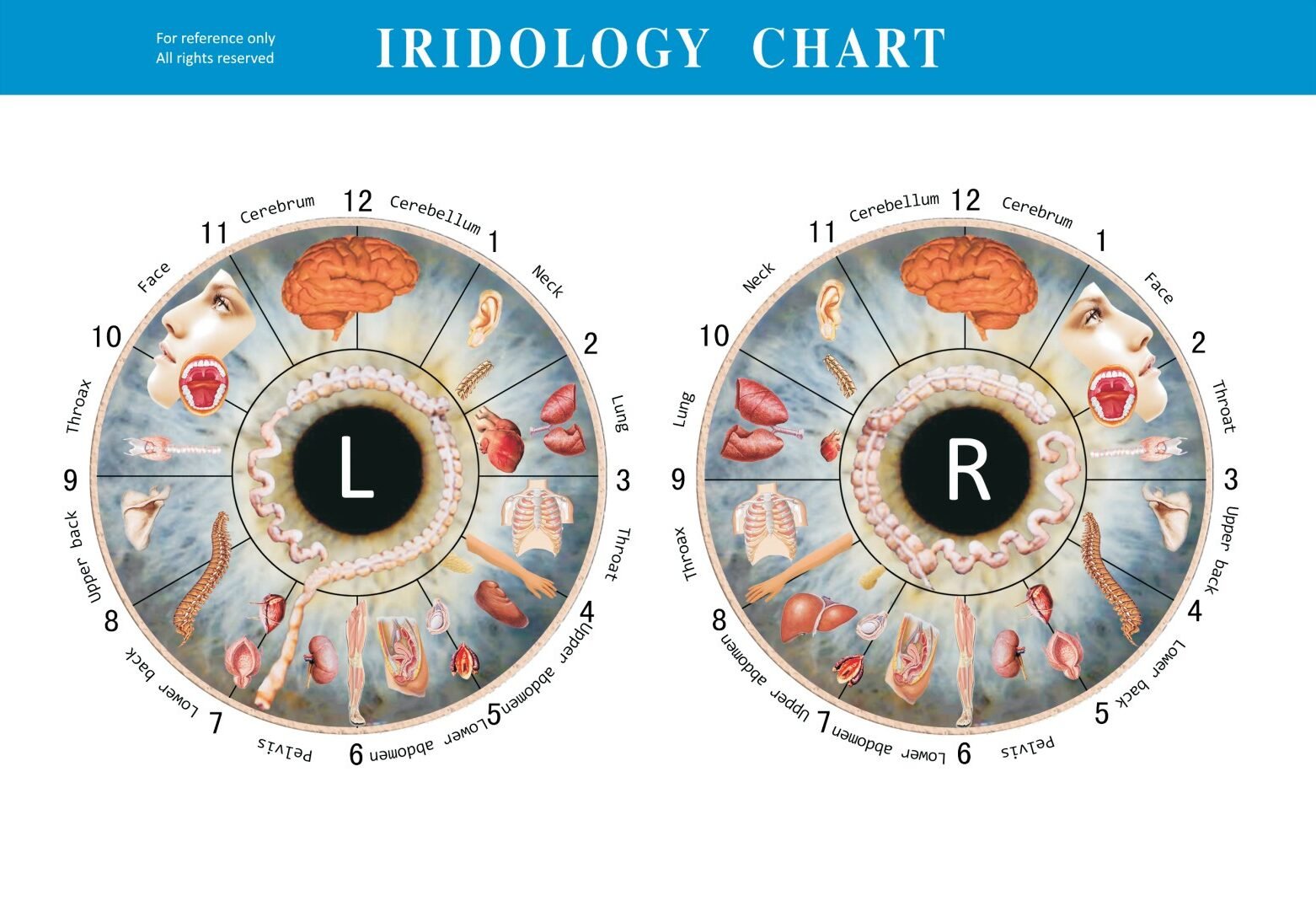

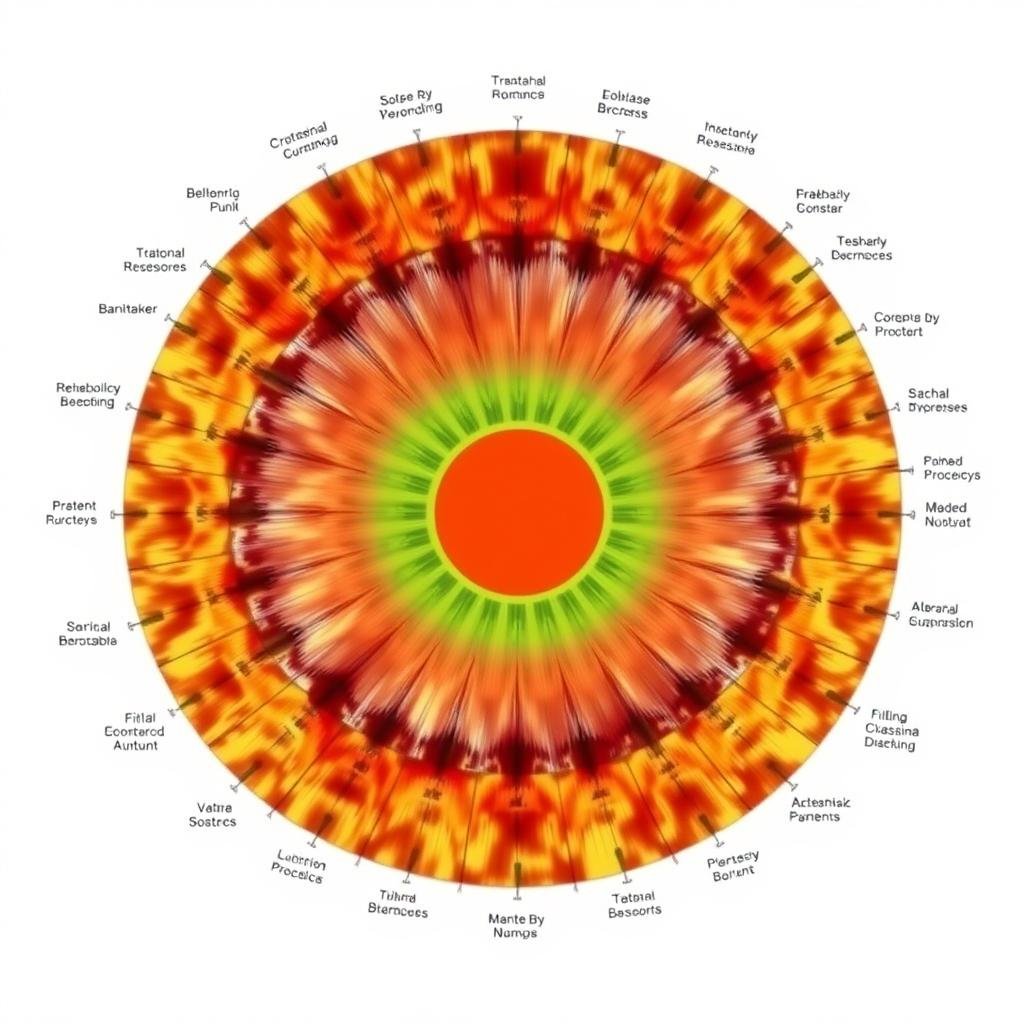
Iridology chart mapping iris zones to corresponding body systems
The foundation of Iridología Diagnóstico de iris lies in the detailed mapping of the iris. Practitioners use specialized charts that divide the iris into approximately 80-90 zones, each corresponding to different organs, glands, and body systems. The right iris is generally associated with the right side of the body, while the left iris corresponds to the left side.
These are the key principles that guide iridology practice:
- El iris contiene miles de terminaciones nerviosas conectadas al cerebro a través del nervio óptico
- Each zone of the iris corresponds to specific organs and tissues
- Changes in iris fibers, colors, and patterns reflect changes in corresponding body tissues
- The iris can show constitutional strengths and weaknesses
- Markings may indicate inflammation, toxin accumulation, or congestion in specific areas
- Iris analysis can reveal health conditions in their early stages before symptoms appear
Iridologists examine specific characteristics including iris fiber structure, color variations, rings, spots, and other markings. For example, white rings around the iris (known as sodium rings) may indicate mineral imbalances, while dark spots might suggest toxin accumulation in specific organs.
Aplicaciones modernas de Iridología Diagnóstico de iris
Today’s iridology has evolved significantly with technological advancements. Modern practitioners often use high-resolution digital cameras specifically designed for iris photography, along with specialized software for detailed analysis. This technology allows for more precise examination and documentation of iris characteristics.
Contemporary applications of Iridología Diagnóstico de iris incluir:
- Preventive health screening to identify potential issues before symptoms develop
- Complementary assessment alongside conventional medical testing
- Identification of constitutional strengths and weaknesses
- Monitoring of healing progress and response to treatments
- Detection of inflammation and toxin accumulation in the body
- Assessment of digestive system function and efficiency
- Evaluation of nervous system stress and adrenal fatigue
- Identification of genetic predispositions to certain health conditions
Many holistic health practitioners incorporate iridology as part of a comprehensive assessment, often alongside other modalities such as nutritional counseling, herbal medicine, and lifestyle coaching. While not intended to diagnose specific diseases, iridology can provide valuable insights into overall health patterns and potential areas of concern.
Discover Your Health Through Your Eyes
Curious about what your iris reveals about your health? Our experienced iridologists use state-of-the-art equipment to provide detailed iris analysis.
Contact Us: +86-13-51090-74-01
The Science Behind Iridología Diagnóstico de iris
The theoretical foundation of Iridología Diagnóstico de iris rests on the complex neurological connections between the iris and the central nervous system. The iris contains thousands of nerve endings that connect to the brain via the optic nerve, potentially creating a pathway for information about the body’s internal state to be reflected in iris structures.
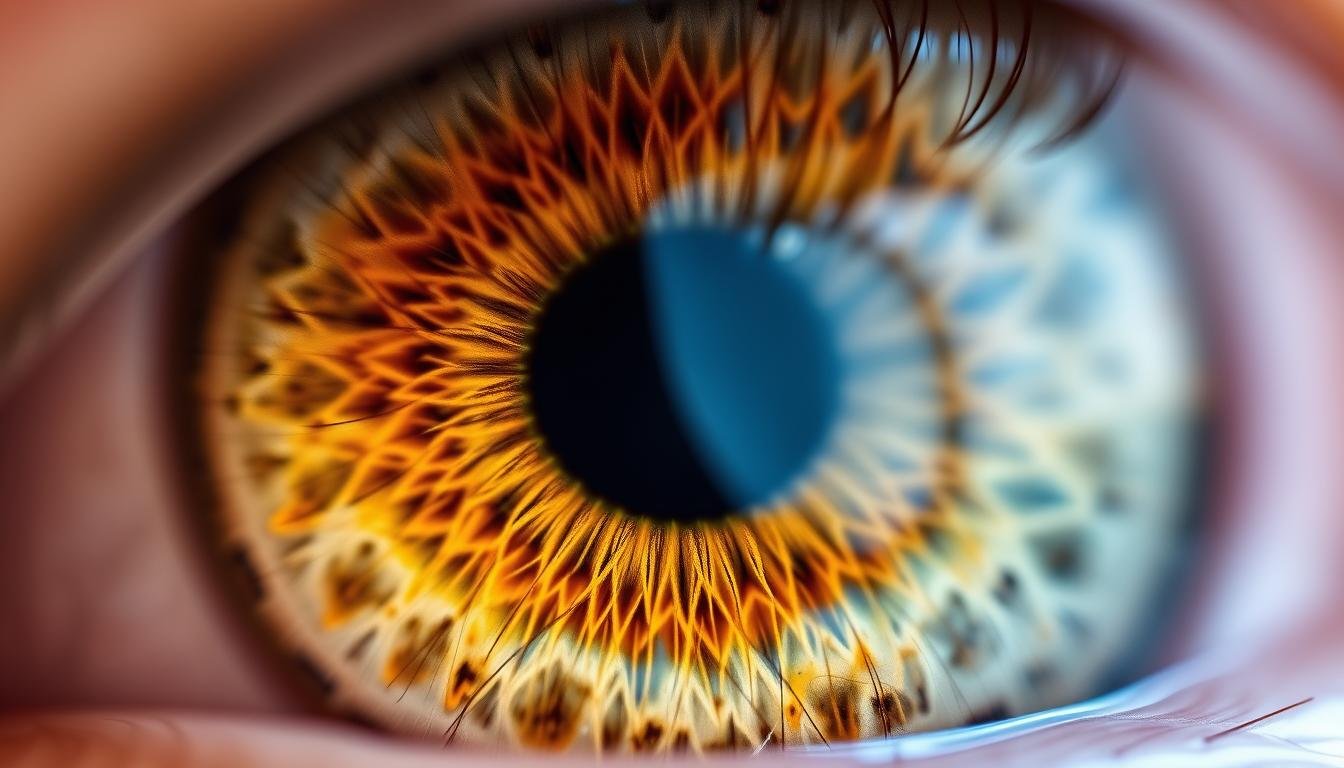
Detailed view of iris structures examined during iridology analysis
Neurological Connections in Iridology
The iris is not merely a colored structure controlling light entry into the eye; it’s a complex tissue containing blood vessels, muscle fibers, and thousands of nerve endings. These nerve fibers connect to the brain through the optic nerve and hypothalamus, which also connects to every major organ system via the autonomic nervous system.
This extensive neural network creates a potential pathway for information about internal organs to be reflected in the iris. Proponents of iridology suggest that when an organ experiences stress, inflammation, or dysfunction, these changes may be communicated through the nervous system and potentially manifest as alterations in iris structure or pigmentation.
Some researchers have proposed that these connections function similar to reflexology maps, where distant body parts are represented in specific locations. However, it’s important to note that the exact mechanisms by which internal conditions might alter iris appearance remain under investigation.
Research and Scientific Evaluation
The scientific community has shown mixed responses to Iridology Iris Diagnoses. While some studies have questioned its diagnostic accuracy, others have found potential correlations between iris signs and certain health conditions. Research in this field continues to evolve.
Some notable research findings include:
- Studies showing correlations between specific iris signs and predispositions to certain conditions
- Research demonstrating relationships between iris constitution types and physiological tendencies
- Investigations into the genetic components of iris structures and their potential health implications
- Case studies documenting changes in iris appearance corresponding with known health changes
It’s worth noting that much of the research supporting iridology comes from practitioners and specialized journals rather than mainstream medical publications. The conventional medical community generally maintains that more rigorous, large-scale studies are needed to validate iridology’s claims.
Technological Advancements in Iris Analysis
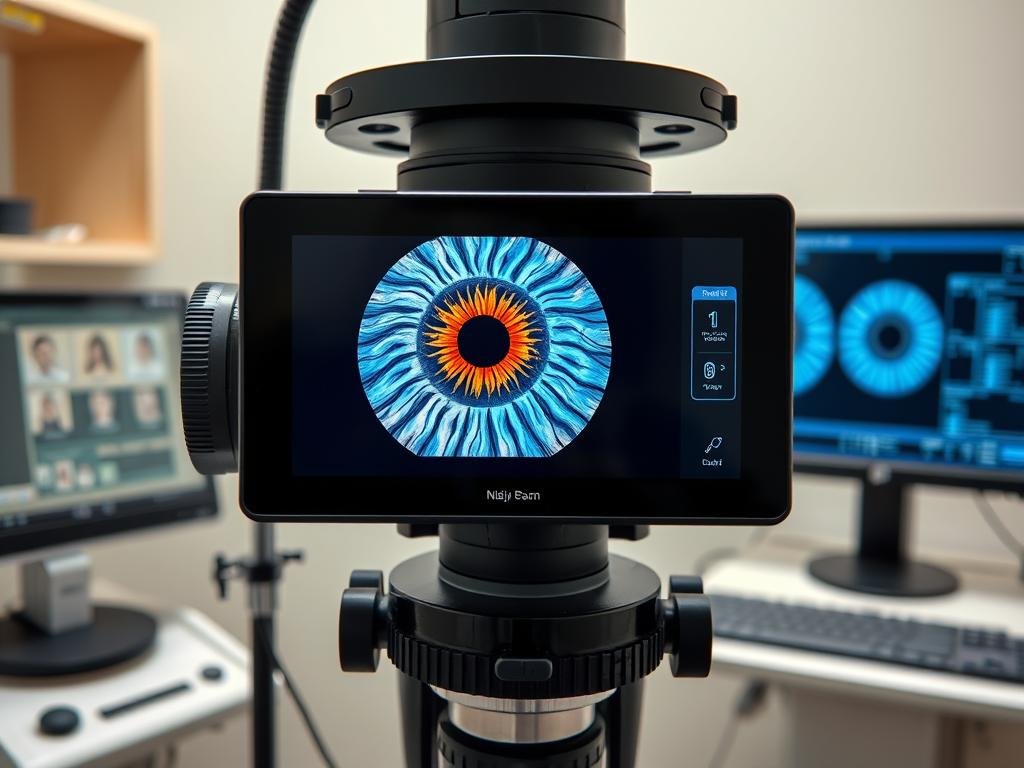
Advanced digital iridology equipment with analysis software
Modern technology has significantly enhanced the practice of Iridología Diagnóstico de iris. Today’s practitioners utilize specialized equipment that far surpasses the simple magnifying glasses used in earlier times:
Imaging Technology
- High-resolution digital iris cameras capturing minute details
- Specialized lighting systems to reveal subtle iris characteristics
- Macro photography equipment for extreme close-up examination
Analysis Software
- Computerized iris mapping and analysis programs
- Automated identification of iris signs and markings
- Digital comparison capabilities to track changes over time
These technological advancements have improved the consistency and precision of iris analysis, allowing for more detailed documentation and more objective assessment than was previously possible. Digital records also enable practitioners to track subtle changes in the iris over time, potentially providing insights into the progression of health conditions or the effectiveness of interventions.
Cómo Iridología Diagnóstico de iris Compares to Blood Tests
Blood testing represents one of the most common and trusted diagnostic methods in conventional medicine. Understanding how Iridología Diagnóstico de iris compares to these established tests helps clarify the potential role of each in health assessment.
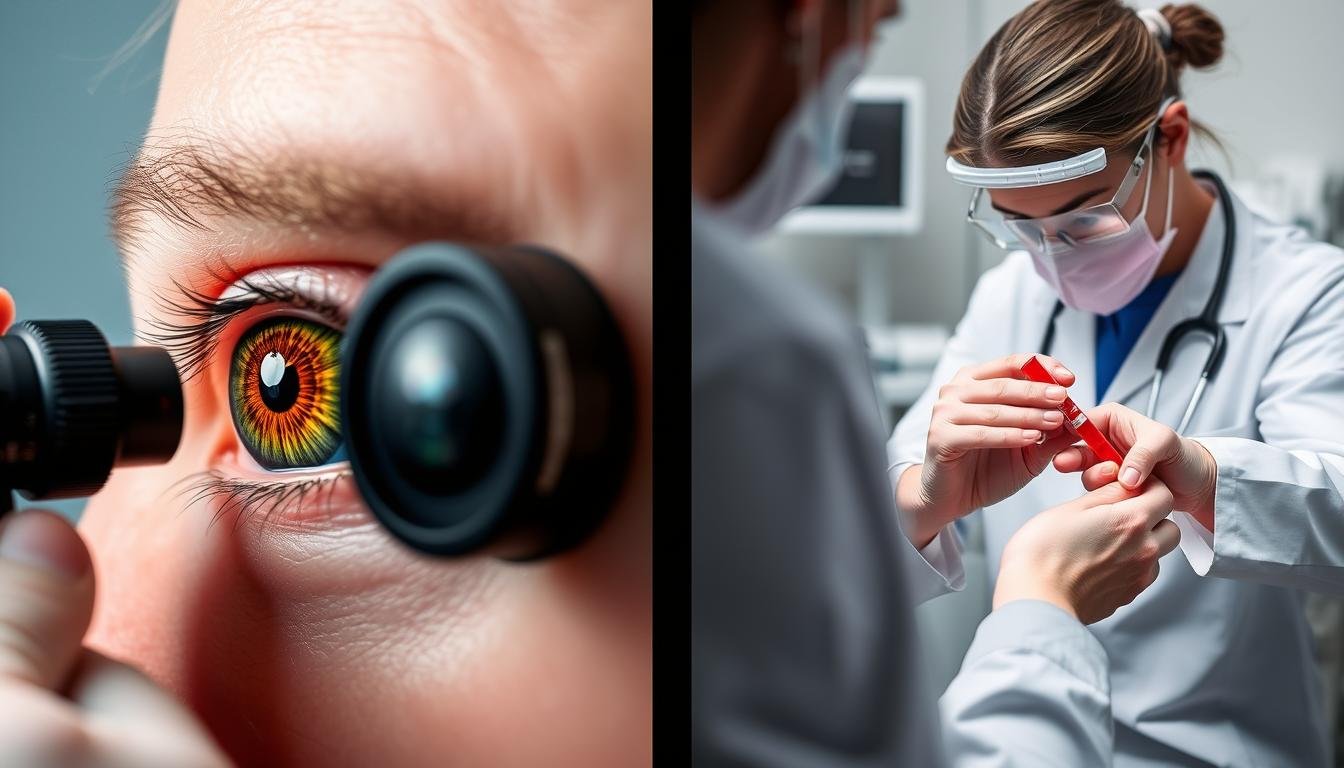
Comparison of non-invasive iridology examination versus conventional blood sampling
Fundamental Differences in Approach
Blood tests and Iridología Diagnóstico de iris represent fundamentally different approaches to health assessment:
| Aspecto |
Blood Tests |
Iridología Diagnóstico de iris |
| Basic Approach |
Measures specific biochemical markers in blood samples |
Analyzes patterns and markings in the iris |
| Invasividad |
Invasive – requires needle insertion and blood drawing |
Non-invasive – visual examination only |
| Enfocar |
Current biochemical status and specific disease markers |
Constitutional tendencies and overall tissue condition |
| Time Perspective |
Snapshot of current conditions |
Historical record of health influences and predispositions |
| Processing |
Laboratory analysis required |
Immediate analysis possible |
While blood tests excel at identifying specific disease markers and measuring current biochemical parameters, iridology takes a more holistic approach, potentially identifying constitutional tendencies and areas of weakness before measurable changes appear in blood work.
Diagnostic Capabilities Comparison
Both methods offer distinct diagnostic capabilities with different strengths and limitations:
Blood Tests Strengths
- Quantitative measurements of specific markers
- Scientifically validated diagnostic criteria
- Ability to detect specific pathogens and antibodies
- Direct measurement of biochemical imbalances
- Widely accepted in medical community
Blood Tests Limitations
- Only shows current biochemical status
- May miss subclinical issues
- Invasive procedure
- Multiple tests often needed for comprehensive assessment
- May not identify root causes of symptoms
Iridology Strengths
- Completely non-invasive
- May identify tendencies before symptoms appear
- Provides whole-body assessment in one examination
- Can reveal constitutional strengths and weaknesses
- May identify areas needing support before clinical disease
Limitaciones de iridología
- Less scientific validation than blood testing
- Interpretation can vary between practitioners
- Cannot diagnose specific diseases definitively
- Less accepted in conventional medical community
- Results may be more general than specific
Complementary Potential of Both Approaches
Rather than viewing these methods as competing alternatives, many health practitioners recognize the value of integrating both approaches. Iridología Diagnóstico de iris may help identify areas requiring further investigation through targeted blood testing, while blood test results can confirm or provide additional context to iridology findings.
For example, if iridology indicates potential liver stress, specific liver function blood tests might be recommended to assess current liver status. Conversely, abnormal blood test results might prompt a closer examination of corresponding iris zones to better understand constitutional factors potentially contributing to the imbalance.
This integrated approach leverages the strengths of both methods—the specificity and scientific validation of blood testing combined with the holistic, preventive perspective of iridology—potentially offering a more comprehensive health assessment than either method alone.
Beyond Standard Blood Tests
Discover what your blood tests might be missing. Our comprehensive iridology assessment can reveal health tendencies not detected by conventional testing.
Email Us: Lucy@iriscope.org
Iridología Diagnóstico de iris vs. Imaging Scans: Key Differences
Modern medical imaging technologies like MRIs, CT scans, X-rays, and ultrasounds have revolutionized diagnostic medicine by allowing physicians to visualize internal structures non-surgically. How does Iridología Diagnóstico de iris compare to these powerful imaging tools?
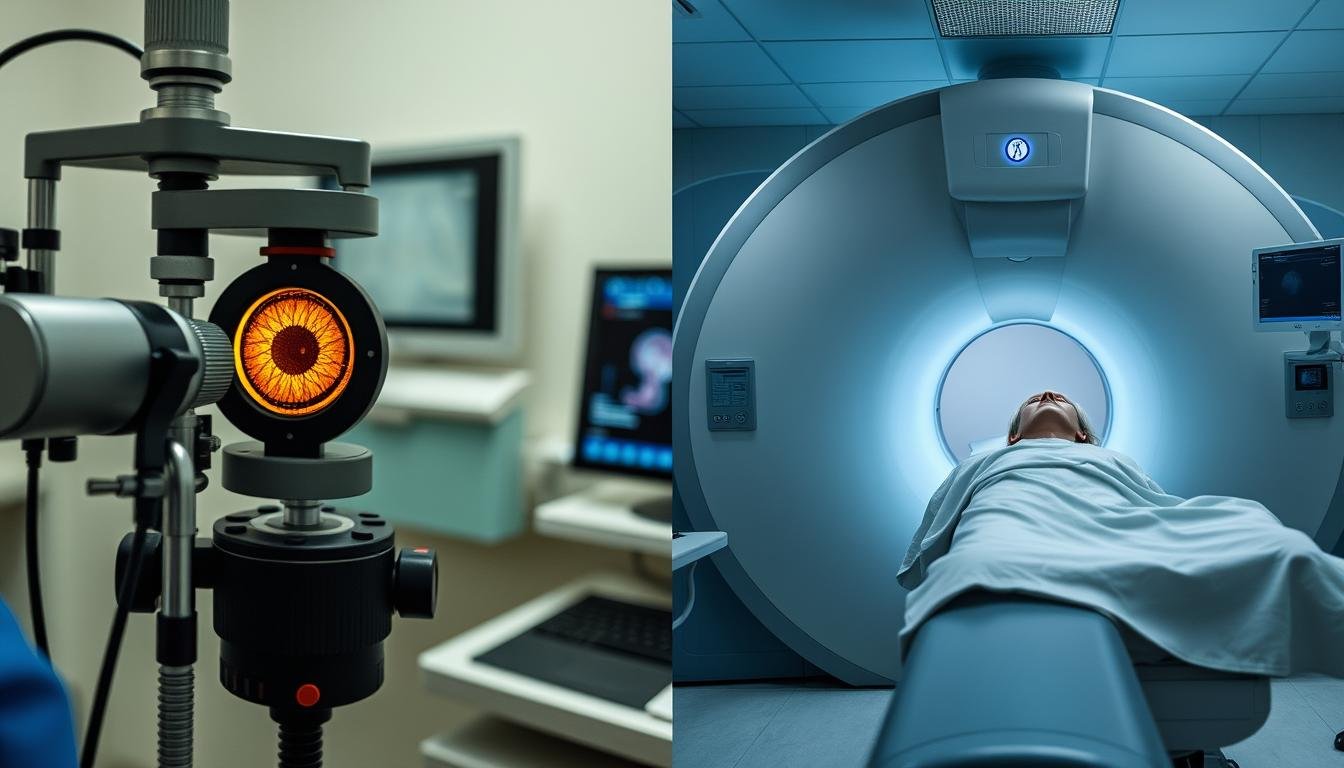
Comparing the experience of iridology examination versus conventional medical imaging
Technological Foundations and Capabilities
Medical imaging and iridology operate on fundamentally different principles and offer distinct capabilities:
| Característica |
Medical Imaging (MRI, CT, X-ray, Ultrasound) |
Iridología Diagnóstico de iris |
| Operating Principle |
Uses radiation, magnetic fields, or sound waves to create images of internal structures |
Analyzes patterns, colors, and markings in the iris |
| What It Shows |
Physical structures, tumors, fractures, abnormalities |
Potential functional imbalances and constitutional tendencies |
| Radiation Exposure |
Some methods use radiation (X-rays, CT scans) |
No radiation exposure |
| Equipment Complexity |
Complex, expensive equipment requiring specialized facilities |
Relatively simple equipment usable in any clinical setting |
| Diagnostic Specificity |
Can identify specific structural abnormalities with high precision |
Identifies general areas of concern rather than specific diagnoses |
Patient Experience and Accessibility
The experience of undergoing medical imaging versus Iridología Diagnóstico de iris differs significantly, as do accessibility factors:
Medical Imaging Experience
- Often requires specialized facilities and appointments
- May involve confined spaces (MRI) or uncomfortable positioning
- Some procedures require preparation (fasting, contrast agents)
- Results typically interpreted by specialists
- Higher cost and potential insurance requirements
Iridology Experience
- Can be performed in any well-lit clinical setting
- Quick, comfortable examination process
- No special preparation required
- Immediate results and discussion possible
- Generally lower cost and fewer access barriers
These differences in accessibility and patient experience make iridology an option for initial screening or complementary assessment, particularly in situations where advanced imaging may be unavailable, cost-prohibitive, or unnecessary based on current symptoms.
Clinical Applications and Integration
Medical imaging and Iridología Diagnóstico de iris serve different clinical purposes and can be integrated in complementary ways:
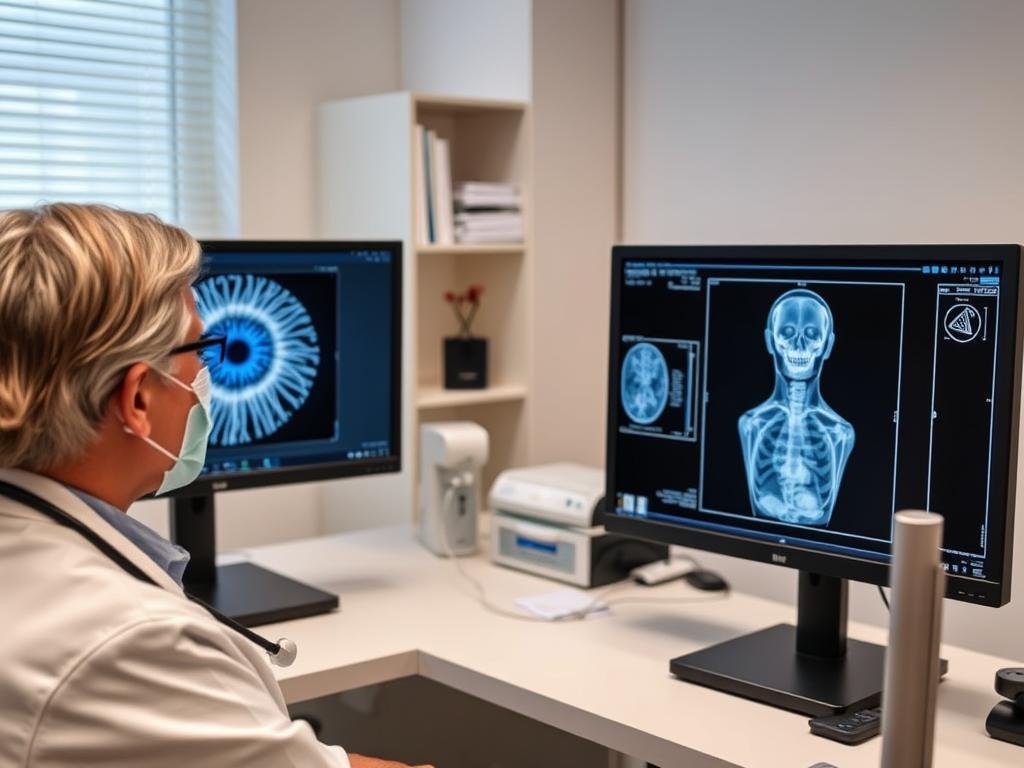
Integrating insights from both iridology and conventional imaging for comprehensive assessment
Medical imaging excels at detecting structural abnormalities like tumors, fractures, and anatomical irregularities. It provides precise visualization of physical structures and can definitively diagnose many conditions. However, it may not detect functional imbalances or early biochemical changes before they manifest as structural problems.
Iridology, conversely, may potentially identify functional tendencies and areas of physiological stress before structural changes occur. While it cannot diagnose specific diseases with the precision of imaging, it may help direct attention to body systems requiring support or further investigation.
An integrated approach might use iridology as an initial screening tool to identify potential areas of concern, followed by targeted medical imaging when specific structural issues are suspected. This complementary approach leverages the strengths of both modalities while acknowledging their respective limitations.
Accuracy Metrics: Iridología Diagnóstico de iris Versus Lab Work
When evaluating any diagnostic method, accuracy is paramount. How does the accuracy of Iridología Diagnóstico de iris compare with conventional laboratory testing? This section examines the evidence and considerations for both approaches.
Measuring Diagnostic Accuracy
Diagnostic accuracy is typically measured using several key metrics:
- Sensitivity – The ability to correctly identify those with a condition (true positive rate)
- Specificity – The ability to correctly identify those without a condition (true negative rate)
- Positive Predictive Value – The probability that subjects with a positive test truly have the condition
- Negative Predictive Value – The probability that subjects with a negative test truly don’t have the condition
- Reproducibility – Whether different practitioners get the same results from the same patient
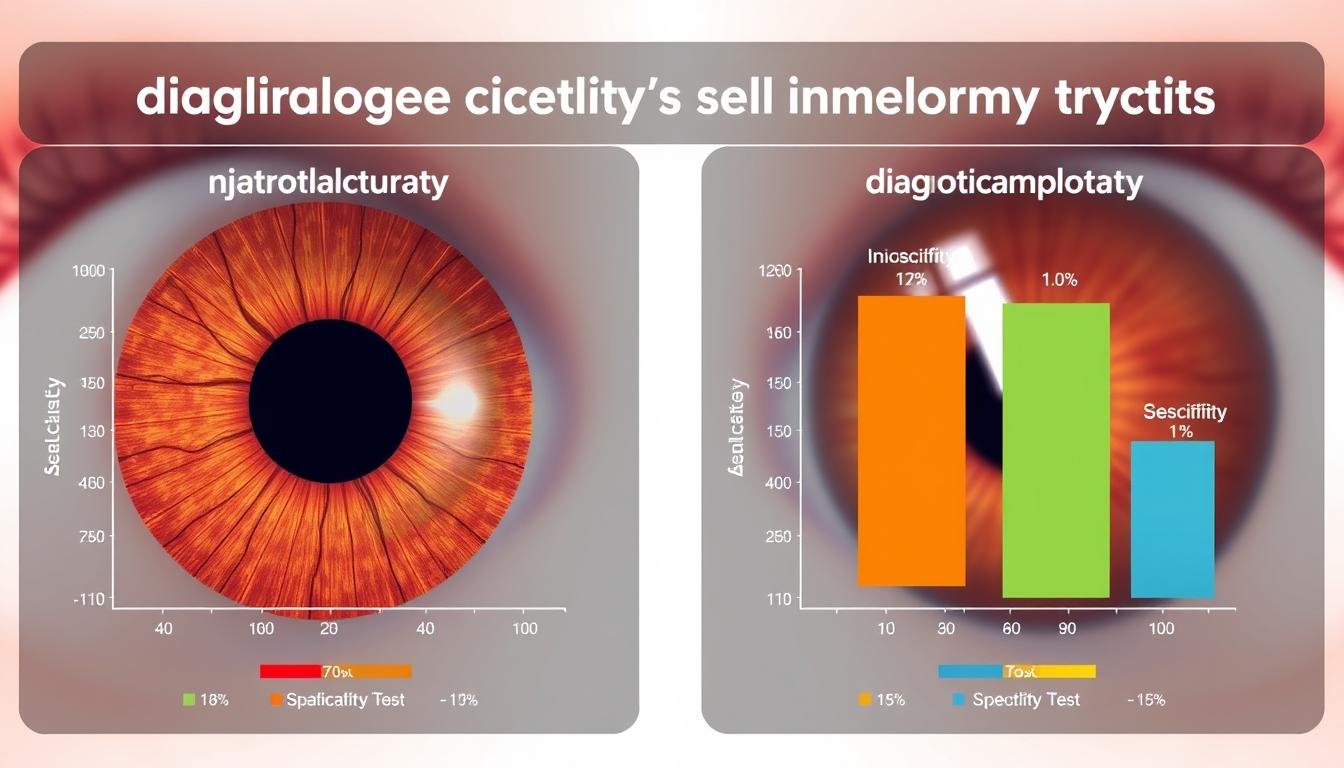
Comparative analysis of diagnostic accuracy metrics between different testing methods
Evidence-Based Comparison
Laboratory testing has been extensively studied and validated through decades of scientific research. Standard blood tests, urinalysis, and other laboratory methods have established reference ranges and documented accuracy rates for specific conditions.
The research on Iridología Diagnóstico de iris presents a more complex picture:
| Aspecto |
Laboratory Testing |
Iridología Diagnóstico de iris |
| Research Volume |
Extensive – thousands of peer-reviewed studies |
Limitado – fewer controlled studies |
| Standardization |
Highly standardized procedures and reference ranges |
Varying methodologies between different schools of practice |
| Reproducibility |
Alto – different labs typically produce similar results |
Variable – practitioner interpretation can differ |
| Condition-Specific Accuracy |
Well-documented for specific conditions |
More research needed for condition-specific validation |
| False Positives/Negatives |
Known rates for specific tests |
Rates not well established |
Some studies have found correlations between certain iris signs and specific health conditions, while others have questioned iridology’s diagnostic accuracy. The mixed research picture suggests that iridology may be more valuable as a complementary assessment tool rather than a standalone diagnostic method.
Practical Considerations for Patients
When considering Iridología Diagnóstico de iris versus laboratory testing, several practical factors come into play:
Laboratory Testing Advantages
- Widely accepted by medical insurance
- Clear diagnostic criteria for many conditions
- Established protocols for treatment based on results
- Quantitative measurements allow tracking over time
- Required for many official diagnoses and treatments
Laboratory Testing Challenges
- Can be expensive, especially without insurance
- May require multiple tests for comprehensive assessment
- Results can fluctuate based on recent activities or diet
- Some tests require fasting or special preparation
- May not detect subclinical imbalances
Iridology Advantages
- Non-invasive and painless
- No special preparation required
- One examination provides whole-body assessment
- May identify tendencies before laboratory markers change
- Often more affordable than comprehensive lab panels
Iridology Challenges
- Rarely covered by medical insurance
- Finding qualified practitioners may be difficult
- Less standardized interpretation
- May not provide definitive diagnoses
- Not typically accepted for official medical documentation
For many individuals, the most practical approach is utilizing both methods appropriately—laboratory testing for specific diagnostic needs and monitoring of known conditions, with iridology potentially serving as a complementary tool for early identification of areas requiring attention and support.
Experience the Difference
Wondering how iridology compares to your recent lab work? Our expert analysis can provide additional insights about your health that conventional tests might miss.
Call Now: +86-13-51090-74-01
Integrating Iridología Diagnóstico de iris with Conventional Medicine
Rather than viewing Iridología Diagnóstico de iris and conventional medicine as competing approaches, many health practitioners and patients are discovering the benefits of thoughtful integration. This complementary approach leverages the strengths of both paradigms while acknowledging their respective limitations.
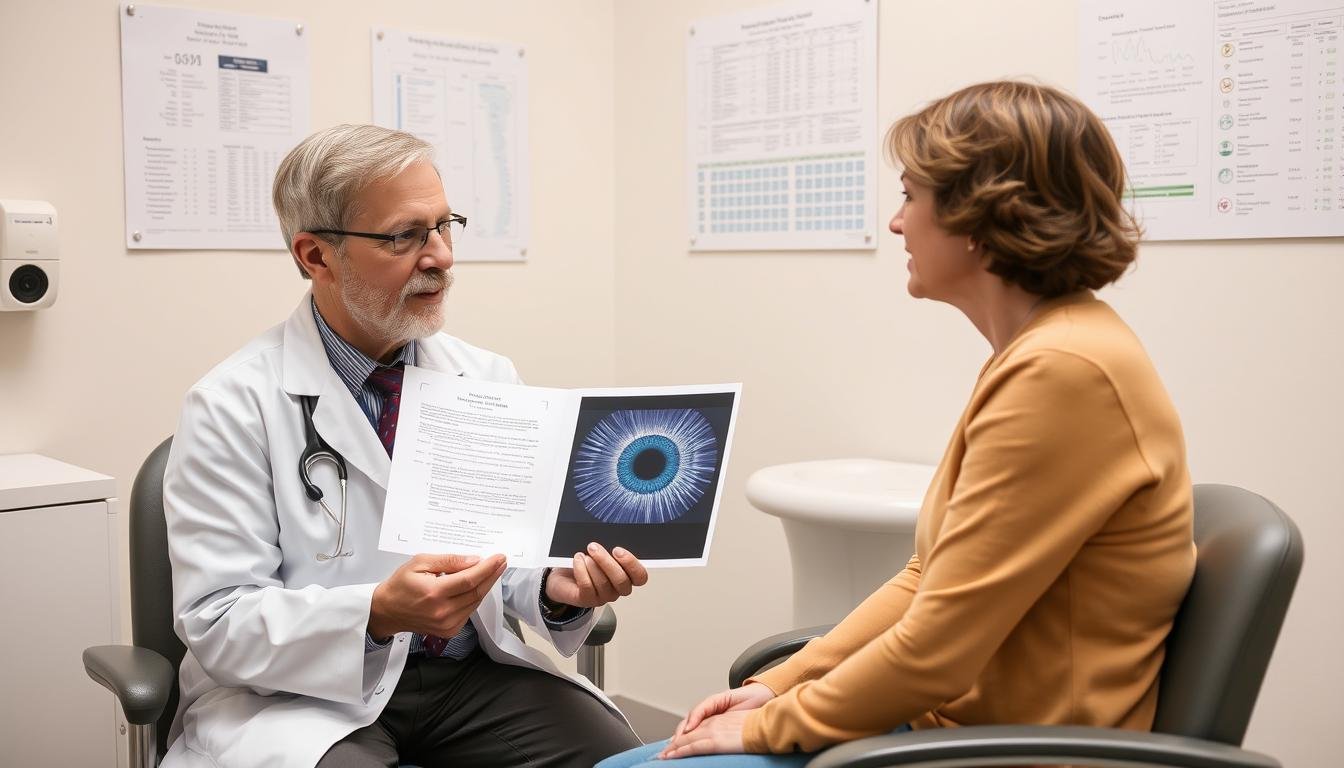
Integrative approach combining insights from both iridology and conventional testing
Complementary Roles in Health Assessment
Conventional medicine and Iridología Diagnóstico de iris can serve complementary roles in a comprehensive health assessment:
Conventional Medicine Strengths
- Definitive diagnosis of established conditions
- Emergency and acute care interventions
- Surgical procedures when necessary
- Pharmaceutical interventions for specific conditions
- Management of advanced disease states
Iridology Potential Contributions
- Early identification of potential health tendencies
- Constitutional assessment and personalized approach
- Monitoring of subtle changes during healing
- Identification of underlying patterns connecting symptoms
- Guidance for preventive health strategies
By recognizing these complementary strengths, practitioners can develop more comprehensive approaches to patient care that address both immediate medical needs and longer-term health optimization.
Practical Integration Strategies
Several practical strategies can help patients and practitioners effectively integrate Iridología Diagnóstico de iris with conventional medical care:
- Maintain open communication – Share iridology findings with your conventional healthcare providers and vice versa to ensure coordinated care.
- Use iridology as a screening tool – Iridology may help identify areas requiring further investigation through conventional testing.
- Confirm findings – When iridology identifies potential issues, consider appropriate conventional tests to confirm and quantify the condition.
- Track progress with both methods – Monitor improvements using both conventional metrics and changes in iris signs.
- Prioritize urgent care appropriately – For acute or severe conditions, seek conventional medical care first, with iridology as a complementary support.
This integrated approach respects both the scientific validation of conventional medicine and the potential insights offered by holistic assessment methods like iridology.
Case Studies: Successful Integration
Examining real-world examples helps illustrate how Iridología Diagnóstico de iris can work alongside conventional medicine:
Case Study: Digestive Health
A patient with chronic digestive complaints had undergone standard testing showing “normal” results despite ongoing symptoms. Iridology assessment revealed signs of potential pancreatic insufficiency and intestinal inflammation. This led to more specialized functional medicine testing that confirmed low pancreatic enzyme production and intestinal permeability issues. The combined insights allowed for a targeted treatment approach addressing the root causes rather than just managing symptoms.
Case Study: Cardiovascular Health
During a routine iridology screening, a practitioner noted signs associated with cardiovascular stress in an otherwise asymptomatic patient. This prompted recommendation for conventional cardiac assessment, which revealed early-stage hypertension and elevated cholesterol levels requiring intervention. The early detection through iridology potentially allowed for earlier lifestyle modifications and monitoring that might have prevented more serious complications.
Case Study: Stress and Adrenal Function
A patient with fatigue and mood fluctuations showed specific iris signs suggesting adrenal stress. While conventional blood tests showed normal thyroid function, subsequent specialized testing confirmed adrenal dysfunction. The integrated approach led to a comprehensive stress management program combining conventional monitoring with targeted nutritional support based on both assessment methods, resulting in significant symptom improvement.
These cases illustrate how Iridología Diagnóstico de iris can complement conventional testing by providing additional perspectives and sometimes directing attention to areas requiring more specialized assessment.
Conclusion: Finding Your Optimal Diagnostic Approach
As we’ve explored throughout this comprehensive comparison, both Iridología Diagnóstico de iris and conventional medical testing offer valuable but different perspectives on health assessment. Rather than viewing these approaches as competing alternatives, consider how they might work together to provide a more complete picture of your health status.
Conventional medical testing excels at identifying specific disease markers, measuring biochemical parameters, and visualizing structural abnormalities. Its scientific validation and standardization make it essential for definitive diagnosis and monitoring of established conditions.
Iridología Diagnóstico de iris, with its holistic perspective and non-invasive nature, may offer complementary insights into constitutional tendencies, functional imbalances, and potential areas requiring support before measurable disease develops. While more research is needed to fully validate its specific claims, many practitioners and patients find value in its whole-person approach.
The optimal approach for most individuals likely involves thoughtful integration of both paradigms—utilizing conventional testing for specific diagnostic needs while exploring the potential insights of iridology for a broader understanding of health patterns and prevention opportunities.
As with any health approach, working with qualified practitioners who understand the strengths and limitations of their methods is essential. The future of healthcare may increasingly embrace such integrative approaches that combine the best of conventional and complementary assessment tools for truly personalized health optimization.
Discover What Your Eyes Reveal About Your Health
Ready to explore how iridology can complement your current health assessment? Our experienced practitioners provide comprehensive iris analysis using state-of-the-art equipment.























